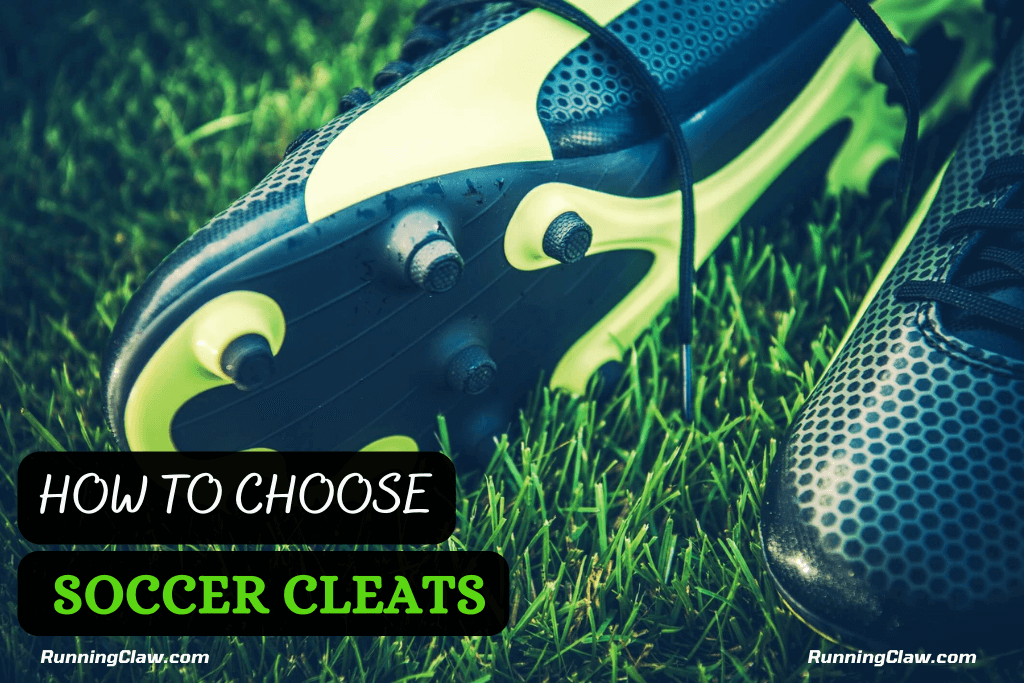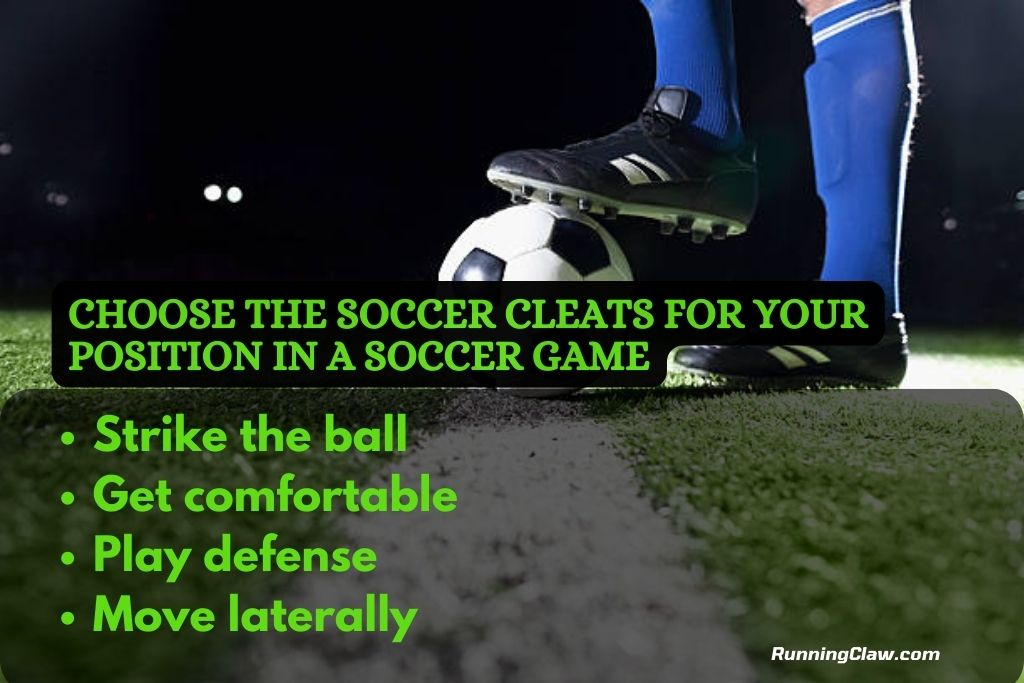Modern soccer cleats look like any other shoes but have sharp spikes at their bottom.
If you have ever wondered what soccer cleats look like on the bottom, here is the answer. Cleats have a raised toe area, designed to give players more power when they kick the ball.
The manufacture and specific cleats style depend on the exact shape and layout of the studs.
In general, they tend to have found studs near the heel in a square shape. Then around the toe box, the cleats often have six studs (3 along each side) with one in the middle.
Cleats are small lumps on the bottom of the shoe that provides grip for a player as they move around the field.
Benefits of Pointed Spikes on Soccer Cleats:
There are toe studs or pointed spikes on the bottom, and there for sure exist for a purpose.
They are the following:
- Give proper traction on the ground.
- Provide support to the ankle, and reduce the chances of slippage.
- The whole foot is protected and remains stable for back movement.
- The toe stud provides the best grip for pushing against heavy opponents but not for soccer-style play.
The following types of soccer cleats:

Soft ground
Cleats are used for rain or wet pitches. They are usually circular, have longer studs, and are made of metal. However, because they’re made of metal, they can be pretty dangerous in tackles.
Soft ground cleats have compatible studs because the pitch isn’t always waterlogged.
Firm ground
They are shorter than soft ground studs and are made of rigid polymer. They are also less dangerous and work on a broader range of playing surfaces.
They will provide a good grip on grass surfaces. Firm ground cleats will also work on most artificial pitches too.
Artificial ground
These cleats are similar to firm ground cleats but are slightly shorter. They’re designed specifically for artificial grass surfaces. You are possibly better off with firm ground cleats. They will work well on turf.
Hard ground
studs are used for parched grass. They are only suitable for really dusty surfaces. Stern ground cleats are made of hard plastic and are very short. They are similar to artificial ground spikes.
What do you call the spikes at the bottom of soccer cleats?
The spikes on the bottom of the soccer cleats are called the studs.
Many spikes on the bottom of cleats help players get a better grip on the field.
The number of spikes can depend on the type of cleats, but they all serve the same purpose: to help players run faster and change directions speedily.
Why do soccer boots have spikes at the bottom?
The spikes, called cleats, can help you stay balanced and focused, and are also helpful for speed, as you can push harder off the ground.
Soccer studs or cleats can be made from plastic, hard rubber, or metal and are often arranged differently, depending on the manufacturer.
Difference between soccer cleats vs. football cleats

Soccer cleats:
- Soccer cleats have no toe spike- shorter.
- Cleats allow players to stay faster to ground and keep balance.
- Plastic leather means more hard-wearing since players use their toes to kickball and give a sense of touch for ball control.
- Shoes are light in weight. Players run more in games.
Football cleats:
- Cleats have an extra spike on the toe.
- Cleats can help the player get extra jump power.
- Shoes are lower cut for baseball to allow more side-to-side motions.
- Football cleats’ sides are higher to provide more ankle support.
- Shoes are heavier, and players do not run as much in-game.
How to choose soccer cleats?

Choosing the exact soccer cleats can be confusing conditions.
If you want to choose the exact cleats to help you perform at your top, you will have to know just what to look for.
The steps are following as
1. You will play on stable surfaces.
If you are playing on a grass pitch where it is not raining too regularly, you should use a pair of ground studs. Stable cleats are the safest cleats.
2. Be prepared for play on soft surfaces.
If you are playing on a pitch where it rains regularly, you should wear a pair of soft ground cleats. Soft ground cleats are similar to those on stable ground cleats.
3. Keep your footing on hard surfaces.
Stern ground cleats are designed to play on grip and balance surfaces. The bottom of a hard-ground soccer cleat is covered in small and flat studs.
4. Handle yourself on the turf.
Various soccer leagues are starting to play on turf. It is easy and cheap to keep. It stays the same in every weather if turf cleats have tiny studs spread out the whole bottom of the soccer cleats.
Do not wear the turf cleats on any other surface than turf. They need studs lengthy or sharp sufficient to grip different surfaces.
Choose the soccer cleats for your position in a soccer game

- Strike the ball,
- Get comfortable
- Play defense,
- Move laterally
1. Strike the ball.
Strike the ball zone of a soccer cleat is the part that preferably should make contact with the ball. The Strike zone is located on the upper front part of the shoe.
2. Get comfortable
Suppose you are a midfielder and spend most of a match running up and down the field. You will need cleats that do not irritate your feet after running. Make sure you pick cleats with comfortable soles and support for your heels.
Some soccer cleats have removable soles.
3. Play defense.
If you are in the defensive position, get soccer cleats with an outsole that can withstand the damage. You will able to stop and change directions easily while tracking opposing forwards.
The outsole is the bottom of the soccer cleats that take damage as you start and stop.
4. Move laterally.
If you are a keeper, the grip is part of your cleats. Cleats can handle your back-and-forth motion. You can dig in your feet and jump from side to side.
Frequently answers the questions:
How many spikes do soccer cleats have?
Soccer cleats are shorter, with two or more spikes covering the ankle.
What is the difference between cleats and spikes?
The spikes increase your speed while the football cleats grip the grass and care for you on your feet. Spikes are chosen based on the occurrence that you run. They are standard for some. Football cleats also come in different styles and offer care for different parts of your foot.
How to clean your soccer cleats?
Cleaning is very important for soccer cleats for the long run. It is the best way to wash with hands and soccer cleats to avoid damage hand washing. Wash with detergent or cleaning solution mixed with hot water and then dry in the air.
Too much heat can damage the soccer cleats, so it’s best to dry them in the air.
What should I look for in a soccer cleat?

Cleats are undoubtedly one of the most important gears for a soccer player. But with so many brands, styles, and price points to choose from, it can be tough to know where to start when selecting a pair. Here are a few things to keep in mind as you shop for your next pair of soccer cleats:
- Is it comfortable or not, has it a right size, because fit and tight size cleats help run faster.
- Ankle support should be keep in mind for the safety purpose
- Durability is a key factor
- Affordability is also important
- Cleats should be best for indoor and outdoor surfaces
Final words
Hence, you know what soccer cleats look like on the bottom, why soccer boots have spikes at the bottom, and about soccer cleats and football cleats.
Moreover, you know how to choose soccer cleats for your positions.
You may also like:


